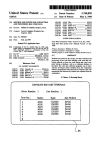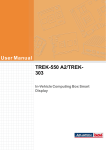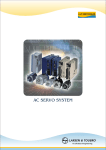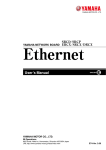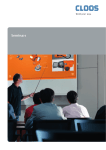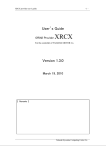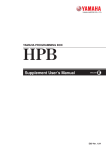Download Yamaha SRCX Instruction manual
Transcript
SRCD/SRCP YAMAHA ROBOT CONTROLLER ERCX/SRCX/DRCX CE marking Supporting Supplement Manual ENGLISH E E72-Ver. 3.00 INTRODUCTION Thank you for purchasing the YAMAHA ERCX/SRCX/DRCX series robot controller. This supplement manual describes the CE marking for ERCX/SRCX/DRCX series robot controller. When shipping the ERCX/SRCX/DRCX series robot controller to or use it in Europe, please be sure to read this manual and follow the instructions for correct operation. This supplement manual describes only the items related to the CE marking. For basic operations and programming of the robot controller, refer to the instruction manual for the robot controller. MEMO Contents Chapter Chapter 1 CE marking ............................................................1 1-1 1-2 1-3 1-4 1-5 1-6 1-7 Safety Information .............................................................................. 2 CE marking ........................................................................................ 3 Safety precautions during robot operation ......................................... 5 Safety precautions during maintenance ............................................. 5 Precautions for motor overload .......................................................... 5 Warning labels.................................................................................... 6 Operating environment ....................................................................... 8 2 Configuration and Connection............................. 9 2-1 Configuration of CE marking controller ............................................ 10 2-2 Connecting the Power Supply .......................................................... 16 Chapter 3 EMC Countermeasures ....................................... 20 3-1 Typical component layout for EMC countermeasures ...................... 21 3-2 Precautions for Cable Connections .................................................. 23 Chapter 4 SPECIFICATIONS ................................................ 24 4-1 CE marking ...................................................................................... 25 MEMO CHAPTER 1234567890123456789012345678901212345678901234567890123456789012123456789012345678901234567890 1234567890123456789012345678901212345678901234567890123456789012123456789012345678901234567890 1234567890123456789012345678901212345678901234567890123456789012123456789012345678901234567890 1234567890123456789012345678901212345678901234567890123456789012123456789012345678901234567890 1234567890123456789012345678901212345678901234567890123456789012123456789012345678901234567890 1234567890123456789012345678901212345678901234567890123456789012123456789012345678901234567890 1234567890123456789012345678901212345678901234567890123456789012123456789012345678901234567890 1234567890123456789012345678901212345678901234567890123456789012123456789012345678901234567890 1 CE marking CHAPTER1 CE marking 1-1 Safety Information To ensure correct and safe use of YAMAHA industrial robots, carefully read this supplement manual and make yourself well acquainted with the contents. FOLLOW THE WARNINGS, CAUTIONS AND USER’S INCLUDED IN THIS SUPPLEMENT MANUAL. It is not possible to detail all safety items within the limited space of this supplement manual. So it is essential that the user have a full knowledge of basic safety rules and also that the operator makes correct judgments on safety procedures during operation. Industrial robots are highly programmable, mechanical devices that provide a large degree of freedom when performing various manipulative tasks. Failure to take necessary safety measures or mishandling due to not following the instruction in this supplement manual may result in trouble or damage to the robot and injury to personnel (robot operator or service personnel) including fatal accidents. Warning information in this supplement manual is shown classified into the following items. DANGER Failure to follow DANGER instruction will result in severe injury or death to the robot operator, a bystander or a person inspecting or repairing the robot. WARNING Failure to follow WARNING instruction could result in severe injury or death to the robot operator, a bystander or a person inspecting or repairing the robot. CAUTION Failure to follow CAUTION instruction may result in injury to the robot operator, a bystander or a person inspecting or repairing the robot, or damage to the robot and/or robot controller. 2 CHAPTER1 CE marking 1-2 CE marking This section provides a basic description of how YAMAHA robot series products are compatible with CE marking. 1-2-1 Safety standards ■ Safety precaution for EC directive applicability The YAMAHA robot series products (robots and controllers) do not fall within the robot systems category. We define the YAMAHA robot series products as equipment to be incorporated (built-in equipment) into your system, and declare that our products conform to the EC directives only within the scope of that equipment. Therefore, although CE marking is affixed to any single unit of YAMAHA robot series products, this means that use of any single unit of YAMAHA robot series products is not guaranteed to conform to the EC directives. When you ship your finished system to or use it in Europe, you are required to verify that your system conforms to EC directives. Differences between the YAMAHA robot series products (robots and controllers) and robot systems. YAMAHA robot series products (robots and controllers) are components used to assemble a robot system and therefore do not constitute a robot system. This is because YAMAHA robot series products do not include the end effector, equipment, devices or sensors required for the robot to perform its tasks, which are listed in the “Robot System” definition in Clause 3.2.20 of the EN775:1992 standard. ■ Applicable directives and standards The table below shows directives and related standards applied to make YAMAHA robots compatible with the CE marking. EC Directives Machinery directives 98/37/EC Low-voltage directives 73/23/EEC 93/68/EEC EMC directives 89/336/EEC 92/31/EEC 93/68/EEC Related Standards Note EN292 EN1050 : Safety of machinery - basic concepts : Safety of machinery - risk assessment *1 EN60204-1 : Safety of machinery - electrical equipment of machines *2 EN55011 EN61000-6-2 : Emission / ISM equipment : Immunity / Industrial environment *3 *1: YAMAHA robot series products are built-in equipment unnecessary to adapt to the machinery directives. However, YAMAHA robot series products conform to the above standards regarding the required items for basic health and safety. *2: The SRCX and DRCX controllers conform to the above directives and related standards. However, the ERCX controller operates on DC 24V and is therefore excluded from the above directives and related standards. *3: YAMAHA robot series products are tested according to the above directives and related standards. EMC countermeasures for a single unit of YAMAHA robots are described in Chapter 3, “EMC Countermeasures”. 3 CHAPTER1 CE marking 1-2-2 Robots subject to CE marking The ERCX/SRCX/DRCX series controller can be used with the following robot series products which are subject to CE marking. Robot Type ERCX SRCX DRCX Single-axis robot FLIP-X series Cartesian type robot XY-X series Pick-and-place type robot YP-X series (Except some models) For more details on model numbers and combinations with peripheral units, consult YAMAHA or YAMAHA dealers. 1-2-3 Safety measures ■ Operating conditions The following description gives major operating conditions for using YAMAHA robot series products. ● EMC (Electromagnetic compatibility) YAMAHA robot series products are products for use in an industrial environment. (Refer to the definition applicable to the EMC directives: Under “Scope” in the first article of the EN61000-6-2 standard. In order to ensure your product conforms to EMC directives, you must evaluate your finished product (entire system) and take necessary countermeasures. EMC countermeasures for single units of YAMAHA robots are listed in “Chapter 3 EMC Countermeasures” on page 20. ● Installation conditions • Since YAMAHA robot series products are built-in equipment, they have a Class I protective structure against electrical shock. The robot and controller must therefore be grounded properly to prevent possible electrical shock. For more details, refer to “2-2-4 Protective bonding” (page 19) in this supplement manual and the Robot User’s Manual. • The robot controller case is not designed as an enclosure that conforms to EN602041 standard. Therefore you must provide appropriate protection against the danger of electrical shock due to inadvertent contact and external environmental problems (dust, water, etc.) • Insulation co-ordination is designed to meet the following conditions. (Refer to the IEC60664-1 standard.) Overvoltage category II Pollution degree II Take proper countermeasures as needed if the robot or controller is used in environments worse than these levels. ● Explosion-proof YAMAHA standard robots and robot controllers are not designed to meet explosionproof specifications. Do not use the robot and controller in environments containing inflammable gas, gasoline or solvent. Explosions or fire may otherwise result. 4 CHAPTER1 CE marking ■ Safety measures for robot ● Protective measures against electrical shock (except robots for ERCX controller) Use the protective ground terminal to ensure safety. Refer to the user’s for details. 1-3 Safety precautions during robot operation ■ The robot must be operated by a person who has received Robot Training from YAMAHA or an authorized YAMAHA dealers. ■ During operation of the robot, be sure to stay out of the working area of the manipulator. Install a safeguard enclosure to keep anyone away from the working area or provide a gate interlock using an area sensor that triggers emergency stop when anyone enters the working area. 1-4 Safety precautions during maintenance ■ Never disassemble the robot or controller. In cases where you have to replace or repair parts used in the robot or controller, first consult with us and follow the user’s we provide. ■ Before beginning maintenance for the robot or controller, be sure to turn off the power to the controller. Even after turning off the controller, there are some parts in the controller which are still hot or at a high voltage. Always wait for at least 5 minutes after the controller is turned off. 1-5 Precautions for motor overload Since abnormal operation of the motor such as “overload” is detected by software, the controller parameters must be set correctly to match the motor type used in the robot which is connected to the controller. Prior to shipping, the controller parameters are preset to match the robot model to be used. When connecting to the robot to the controller, check the robot model again. If any abnormality is found during operation, stop the controller and contact us for corrective action. 5 CHAPTER1 CE marking 1-6 Warning labels The following labels are affixed to the SRCX/DRCX controller to emphasize what you must do or must not do to ensure safety. (These warning labels are not affixed to the ERCX.) To use the YAMAHA robot and controller safely and correctly, be sure to observe the caution and instruction on the labels. ■ Label warning of Read instruction manual 1-6-1 ■ Label warning of high temperature ■ Label warning of electrical shock ■ Label warning of 200V only Warning labels locations High temperature warning label Electrical shock warning label “Read instruction manual” label AC 200V warning label SRCX controller High temperature warning label Electrical shock warning label “Read instruction manual” label AC 200V warning label DRCX controller 6 CHAPTER1 CE marking 1-6-2 Meaning of warning labels ■ “Read instruction manual” label This label indicates that important items you must know are described in the instruction manual. The followings are particularly important. • The power fuses in the controller are located on both sides of L/N. (See Fig. 2-4, “Power supply and emergency stop circuit block diagram (SRCX)”(page 13), and also Fig. 2-6, “Power supply and emergency stop circuit block diagram (DRCX)”(page 15). • When one end of the power supply is grounded, connect the grounded side to the N side of the controller power input terminal. to the protec• Be sure to connect the controller’s protective conductor terminal tive conductor on the user side. to the protective • Be sure to connect the robot’s protective conductor terminal conductor of the user’s system. ■ High temperature warning label Indicates that the area around this waning label is very hot. Do not touch any part of this area during operation to prevent burn. ■ Electrical shock warning label Indicates that a high voltage is applied to some parts in the controller. Never touch the connectors or terminals during operation. ■ AC 200V warning label Indicates that the power supply connected to the controller must be AC 200V±10%. 7 CHAPTER1 CE marking 1-7 Operating environment ■ Installation location Install the robot controller indoors, at a height of less than 1000 meters above sea level. ■ Operating temperature The ambient temperature should be maintained within a range of 0 to 40°C during operation. This is the range in which continuous operation of the robot controller is guaranteed according to the initial specifications. If the robot controller is installed in a narrow space, heat generated from the controller itself and from peripheral equipment may drive the temperature above the allowable operating temperature range. This may result in thermal runaway or malfunction and may lower component performance along with shortening their useful service life. So be sure to install the controller in locations with a vent having a natural air flow. If this proves insufficient provide forced air-cooling. ■ Operating humidity The ambient humidity of the robot controller should be kept 35 to 85% RH (no condensation) in order to guarantee continuous operation within the initial specifications. ■ Storage temperature The controller should be stored in a location having an ambient temperature range from -10 to +65°C when not being used. If the robot controller is stored in a location at high temperatures for extended periods, deterioration of the electronic components may occur and the memory backup time may decrease. ■ Storage humidity The controller should be stored in a location having an ambient humidity below 95% RH when not being used. If the robot controller is stored in a location with high humidity for an extended period of time, rust may form on the electronic components. ■ Vibration and shock Do not apply excessive shocks or constant vibrations to the robot controller. Install the robot controller in a location not subject to vibrations. ■ Atmosphere (gas etc.) Do not install the robot controller in locations where conductive dust particles, hydrogen sulfide gas or sulfurous acid gas are present. Such an atmosphere may cause the components to erode. 8 CHAPTER 1234567890123456789012345678901212345678901234567890123456789012123456789012345678901234567890 1234567890123456789012345678901212345678901234567890123456789012123456789012345678901234567890 1234567890123456789012345678901212345678901234567890123456789012123456789012345678901234567890 1234567890123456789012345678901212345678901234567890123456789012123456789012345678901234567890 1234567890123456789012345678901212345678901234567890123456789012123456789012345678901234567890 1234567890123456789012345678901212345678901234567890123456789012123456789012345678901234567890 1234567890123456789012345678901212345678901234567890123456789012123456789012345678901234567890 1234567890123456789012345678901212345678901234567890123456789012123456789012345678901234567890 2 Configuration and Connection This chapter explains the configuration of the CE marking controller and the connections to the power supply. CHAPTER2 Configuration and Connection 2-1 Configuration of CE marking controller 2-1-1 Controller basic configuration (ERCX) Fig.2-1 shows the ERCX controller basic block diagram. Fig.2-1 ERCX controller block diagram 10 CHAPTER2 Configuration and Connection 2-1-2 Power supply and emergency stop configuration (ERCX) Fig.2-2 shows the power supply and emergency stop block diagram for ERCX. Fig.2-2 Power supply and emergency stop block diagram (ERCX) 11 CHAPTER2 Configuration and Connection 2-1-3 Controller basic configuration (SRCX) Fig.2-3 shows the SRCX controller basic block diagram. Fig.2-3 SRCX controller block diagram 12 CHAPTER2 Configuration and Connection 2-1-4 Power supply and emergency stop configuration (SRCX) Fig.2-4 shows the power supply and emergency stop block diagram for SRCX. Fig.2-4 Power supply and emergency stop block diagram (SRCX) 13 CHAPTER2 Configuration and Connection 2-1-5 Controller basic configuration (DRCX) Fig.2-5 shows the DRCX controller basic block diagram. Fig.2-5 DRCX controller block diagram 14 CHAPTER2 Configuration and Connection 2-1-6 Power supply and emergency stop configuration (DRCX) Fig.2-6 shows the power supply and emergency stop block diagram for DRCX. Fig.2-6 Power supply and emergency stop block diagram (DRCX) 15 CHAPTER2 Configuration and Connection 2-2 Connecting the Power Supply 2-2-1 Power supply ■ ERCX controller DriverType Power supply voltage No. of phases Frequency Max. power consumption - DC24V ±10% - - 3A ■ SRCX controller DriverType Power supply voltage No. of phases Frequency Max. power consumption 05 AC200V ±10% Single phase 50/60Hz 400 VA 10 AC200V ±10% Single phase 50/60Hz 600 VA 20 AC200V ±10% Single phase 50/60Hz 1000 VA Max. power consumption ■ DRCX controller DriverType Power supply voltage No. of phases Frequency 0505 AC200V ±10% Single phase 50/60Hz 500 VA or less 0510 AC200V ±10% Single phase 50/60Hz 700 VA or less 0520 AC200V ±10% Single phase 50/60Hz 1100 VA or less 1005 AC200V ±10% Single phase 50/60Hz 700 VA or less 1010 AC200V ±10% Single phase 50/60Hz 900 VA or less 1020 AC200V ±10% Single phase 50/60Hz 1300 VA or less 2005 AC200V ±10% Single phase 50/60Hz 1100 VA or less 2010 AC200V ±10% Single phase 50/60Hz 1300 VA or less 2020 AC200V ±10% Single phase 50/60Hz 1600 VA or less CAUTION On the SRCX and DRCX controllers designed for CE marking, the power supply must be AC 200V±10%. If the power supply voltage drops below the above listed range during operation, an alarm circuit triggers so that the controller operation misht return to the initial conditions or come to an alarm stop. To avoid such problems from power supply fluctuations, a stable power supply with less than ±10% fluctuation should be used. The controller has a capacitor input type power supply, so a large current surge occurs when the power is turned on. Avoid using quick-blow circuit breakers and fuses. For the same reason, avoid turning the power off and on again repeatedly within an interval of less than 10 seconds. This could eventually damage the main circuit elements in the controller. 16 CHAPTER2 Configuration and Connection C A U T I O N (ERCX controller only) The power consumption listed above is for ERCX controller only. Additional power should be supplied for the mechanical brake and I/O control via the I/O connector. If the current supplied to the controller is insufficient, an alarm stop or abnormal operation may occur. So, carefully select a 24V power supply to match your application needs. A 24V power supply with adequate current capacity may help to upgrade robot performance. For detailed information, contact our sales office or dealer. Power supply current required by I/O connector of ERCX controller. Power supply current required by I/O control: 50mA for emergency stop circuit + current capacity for I/O drive (depends on user application) Power supply current required by brake control: 300mA for mechanical brake (if used) 2-2-2 Connecting the power supply (ERCX) Use the power plug (supplied) to connect the power supply to the POWER connector on the ERCX controller. Referring to the figure below, make correct connections to each terminal. Misconnections may lead to serious accidents such as fire. The end of each wire must be fastened with a screw so that it will not come off the plug. If the controller becomes unstable due to noise, use of a ferrite core on the power supply line is recommended as shown below. ERCX 1 2 3 1. 24V 2. N(0V) 3. (Grand) Wire thicker than 2 1.25mm Fig. 2-7 Power supply connections CAUTION The ERCX controller does not have a power switch. Be sure to provide a power supply breaker (isolation) of the correct specifications that will turn power on and off to the entire system including the robot controller. 17 CHAPTER2 Configuration and Connection CAUTION When connecting the power supply to the ERCX controller, the cable length between the ERCX controller and the AC adapter for supplying DC power to the ERCX controller should be less than 10 meters, in order to prevent external surge intrusion into the power cable. Also take the necessary measures so that no one except service personnel can unplug the power cable. DANGER Before you start wiring work, make sure that the power for the entire system is turned off. Doing wiring work while power is still on can cause electrical shocks. 2-2-3 Connecting the power supply (SRCX, DRCX) Connect the power supply to the terminal block on the controller. Make the correct connections to each terminal while referring to the marks printed on the panel. Misconnections may lead to serious accidents such as fire. The end of each wire must be crimped so that it will not come off the terminal block. On the SRCX and DRCX controllers designed for CE marking, the power supply must be AC 200V±10%. 1. L (AC IN) 2. N (AC IN) 3. (Ground) 4. NC (No connection) 5. T1 and T2 (for input voltage setting) Leave open Fig. 2-8 Power supply connections CAUTION The SRCX and DRCX controllers does not have a power switch. Be sure to provide a power supply breaker (isolation) of the correct specification that will turn power on and off to the entire system including the robot controller. DANGER Before you start wiring work, make sure that the power supply for the entire system is turned off. Doing wiring work while power is still on can cause electrical shock. 18 CHAPTER2 Configuration and Connection 2-2-4 Protective bonding The robot controller is built in to the equipment, so it has a protective structure of Class I against electrical shock. To prevent electrical shock, be sure to ground the protective conductor terminal of the robot controller by connecting it to the protective conductor of the entire system. The protective conductor terminal of the robot controller is marked with the symbol shown below. Protective conductor terminal symbol : 417-IEC-5019 2-2-5 Insulation co-ordination Insulation co-ordination was designed to meet the following conditions. (Refer to the description of IEC60664-1 standards.) ■ Overvoltage category II ■ Pollution degree II If the robot or controller is used in environments worse than these levels, take proper countermeasures as needed. 2-2-6 Isolation Resistance and Voltage BreakdownTests Never attempt isolation resistance tests or voltage breakdown tests on the controller. Since capacitive grounding is provided between the controller body and 0V, these tests may result in detecting excessive leakage current or damage to internal circuitry. If these tests are required, please consult your YAMAHA sales office or representative. 19 CHAPTER 1234567890123456789012345678901212345678901234567890123456789012123456789012345678901234567890 1234567890123456789012345678901212345678901234567890123456789012123456789012345678901234567890 1234567890123456789012345678901212345678901234567890123456789012123456789012345678901234567890 1234567890123456789012345678901212345678901234567890123456789012123456789012345678901234567890 1234567890123456789012345678901212345678901234567890123456789012123456789012345678901234567890 1234567890123456789012345678901212345678901234567890123456789012123456789012345678901234567890 1234567890123456789012345678901212345678901234567890123456789012123456789012345678901234567890 1234567890123456789012345678901212345678901234567890123456789012123456789012345678901234567890 3 EMC Countermeasures To conform to EMC directives, implement the appropriate EMC countermeasures for your finished product (entire system). The following description and circuits are typical EMC countermeasures for a single unit of YAMAHA robot, just for your reference. CHAPTER3 EMC Countermeasures 3-1 Typical component layout for EMC countermeasures The following countermeasures are typical methods for testing the robot and controller under YAMAHA installation conditions. When the robot and controller are used while installed in your system, the actual test results may differ depending on installation conditions. 3-1-1 Typical component layout for EMC countermeasures (ERCX) Fig.3-1 EMC countermeasures for ERCX 3-1-2 Typical component layout for EMC countermeasures (SRCX) Fig.3-2 EMC countermeasures for SRCX 21 CHAPTER3 EMC Countermeasures 3-1-3 Typical component layout for EMC countermeasures (DRCX) Fig.3-3 shows a typical component layout for EMC countermeasures when the DRCX controller is used in combination with a YAMAHA cartesian or pick-and-place type robot. Fig.3-4 shows a typical component layout for EMC countermeasures when the DRCX controller is used in combination with two YAMAHA single-axis robots. EMC countermeasures for DRCX and Cartesian or P&P robot Fig.3-3 EMC countermeasures 1 for DRCX EMC countermeasures for DRCX and single-axis robots Fig.3-4 EMC countermeasures 2 for DRCX 22 CHAPTER3 EMC Countermeasures 3-2 Precautions for Cable Connections Various cables are used to connect the robot controller to peripheral devices. Lay out AC cables as separately from low DC cables as possible. ■ AC cables • Power cable • Motor cable ■ Low DC cables • TPB cable, communication cable • I/O cable • Robot I/O cable 23 CHAPTER 1234567890123456789012345678901212345678901234567890123456789012123456789012345678901234567890 1234567890123456789012345678901212345678901234567890123456789012123456789012345678901234567890 1234567890123456789012345678901212345678901234567890123456789012123456789012345678901234567890 1234567890123456789012345678901212345678901234567890123456789012123456789012345678901234567890 1234567890123456789012345678901212345678901234567890123456789012123456789012345678901234567890 1234567890123456789012345678901212345678901234567890123456789012123456789012345678901234567890 1234567890123456789012345678901212345678901234567890123456789012123456789012345678901234567890 1234567890123456789012345678901212345678901234567890123456789012123456789012345678901234567890 4 SPECIFICATIONS CHAPTER4 SPECIFICATIONS 4-1 CE marking 4-1-1 ERCX sereis controller Model Specification item Applicable motor capacitance Basic External dimensions specifiWeight cations Used power supply voltage No. of controllable axes Control method Position detection method Speed setting Axis Acceleration/deceleration control setting Servo adjustment No. of encoder pulses Lead length Memory I/O ROM RAM No. of program steps No. of programs No. of points No. of multi tasks Origin detection method Teaching method Auxiliary memory unit I/O input I/O output Drive power supply Brake output Emergency stop input Serial interface Network (option) Ambient temperature General Storage temperature specification Ambient humidity CE marking ERCX DC24V, 30W or less W30 × H250 × D157mm 0.9kg DC24V±10%, 3A*1 1 axis AC full digital servo PTP Resolver with multi-turn data backup function 100-step setting possible per program step Automatically set according to robot type and transportation weight. 100-step setting is also possible with acceleration parameter. Handled with parameters (special). Servo gain, current limit, etc. 16384P/R Lead length is selectable during initialization or by parameter setting 256K bytes (with CPU incorporated) 128K bytes with 64K lithium battery backup (5-year life) 3000 steps/total or less, 255 steps/program 100 1000 points 4 Origin search by stroke end detection or absolute reset MDI (coordinate value input), teaching playback, direct teaching IC memory is available as TPB option General-use 16 points, special-use 8 points General-use 13 points, special-use 3 points, open collector output (0.1A/24V maximum per output) External DC24V±10%, more than 50mA*2 Relay output (for 24V/300mA brake), one channel Normal closed contact input (origin return not required after emergency stop is released) One RS-232C channel (for communication with TPB or general purpose personal computer) CC-Link, DeviceNet, EtherNet 0 to 40 degrees -10 to 65 degrees 35 to 85%RH (with no condensation) See 1-2-1, “Safety standards”, and Chapter 3, “EMC Countermeasures”. *1: When controlling a brake and I/O operations, a separate 24V power supply with a necessary capacity must be connected to the I/O connectors. The robot performance may be enhanced if a 24V power supply with an adequately large capacity is available. Please consult us for more details. *2: When no brake and I/O control are used. An additional power supply will be needed to provide power for the brake and I/O control. Note) Specifications and external appearance are subject to change without prior notice. 25 CHAPTER4 SPECIFICATIONS 4-1-2 SRCX sereis controller Model Specification item Applicable motor capacitance*1) Basic Max. power consumption specifiExternal dimensions cations Weight Used power supply voltage No. of controllable axes Control method Position detection method Speed setting Axis Acceleration/deceleration control setting Servo adjustment No. of encoder pulses Lead length SRCX-05 SRCX-10 SRCX-20 200V, 100W or less 200V, 200W or less 200V, 600W or less 400VA 600VA 1000VA W78 × H250 × D157mm 1.5kg Single-phase AC200V within ±10% 50/60Hz 1 axis AC full digital servo PTP Resolver with multi-turn data backup function 100-step setting possible per program step Automatically set according to robot type and transportation weight. 100-step setting is also possible with acceleration parameter. Handled with parameters (special). Servo gain, current limit, etc. 16384P/R Lead length is selectable during initialization or by parameter setting (special function) ROM 256K bytes (with CPU incorporated) RAM 128K bytes with 64K lithium battery backup (5-year life) No. of program steps 3000 steps/total or less, 255 steps/program No. of programs 100 Memory No. of points 1000 points No. of multi tasks 4 Teaching method MDI (coordinate value input), teaching playback, direct teaching Auxiliary memory unit IC memory is available as TPB option I/O input General-use 16 points, special-use 8 points I/O output General-use 13 points, special-use 3 points, open collector output (0.5A/24V maximum per output) External drive power supply 24V/600mA (when not using brake) Brake output Relay output (for 24V/300mA brake), one channel, built-in power supply (24V) Origin sensor input Connectable to a DC24V B-contact sensor Emergency stop input Normal closed contact input (origin return not required after emergency stop is released) Serial interface One RS-232C channel (for communication with TPB or general purpose personal computer) Network (option) CC-Link, DeviceNet, EtherNet Ambient temperature 0 to 40 degrees General Storage temperature -10 to 65 degrees specification Ambient humidity 35 to 85%RH (with no condensation) CE marking See 1-2-1, “Safety standards”, and Chapter 3, “EMC Countermeasures”. *1) The regenerative unit (RGU-2) is required to operate a load with large inertia or a robot model specified by YAMAHA. Note) Specifications and external appearance are subject to change without prior notice. 26 CHAPTER4 SPECIFICATIONS 4-1-3 DRCX sereis controller Model Specification item Applicable motor capacitance Basic Max. power consumption specifiExternal dimensions cations Weight Used power supply voltage No. of contr ollable axes Control method Position detection method Speed setting Axis Acceleration/deceleration control setting Servo adjustment No. of pulses Lead length Memory I/O ROM RAM No. of program steps No. of programs No. of points No. of multi tasks Teaching method Auxiliary memory unit I/O input I/O output Exter nal drive power suppl y Brake output Origin sensor input Emergency stop input Serial interface Network (option) Ambient temperature Storage temperature General specification Ambient humidity CE marking DRCX Total power 1200W max. * 1600VA W100 × H250 × D157mm 2.1kg Single-phase AC200V within ±10% 50/60Hz 2 axes AC full digital servo PTP, CP*2), ARC *2) Resolver with multi-turn data backup function 100-step setting possible per program step Automaticallyset according to robot type and transportation weight. 100-ste p setting is also possible with acceler ation parameter. Handled with parameters (special). Servo gain, current limit, etc. 16384P/R Lead length can be selected during initial processing or by parameter setting (custom order) 256K bytes (with built-in CPU) 128K bytes with 64K lithium battery backup (5-year life) 3000 steps/total or less, 255 steps/program 100 1000 points 4 MDI (coordinate value input), teaching playback, direct teaching IC memor y is available as TPB option General-use 16 points, special-use 8 points General-use 13 points, special-use 3 points, open collector output (0.5A/24V max. per output) 1) DC24V/900mA (when not using brake) Relay output (for 24/300mA brake), two channel, built-in power supply (24V) Connectable to a DC24V B-contact senser Normal closed contact input (origin return not required after emergency stop is released) One RS-232C channel (for communication with TPB or general purpose personal computer) CC-Link, DeviceNet, EtherNet 0 to 40 degrees -10 to 65 degrees 35 to 85%RH (with no condensation) See 1-2-1, “Safety standards”, and Chapter 3, “EMC Countermeasures”. *1) A regenerative unit (RGU-2) is required when operating robot models specified by YAMAHA or a robot handling a load with large inertia. *2) Only for Cartesian robot. Note) Specifications and external appearance are subject to change without prior notice. 27 Supporting Supplement Manual SRCD/SRCP ERCX/SRCX/DRCX Robot Controller May 2007 Ver. 3.00 CE marking This manual is based on Ver. 3.00 of Japanese manual. © YAMAHA MOTOR CO., LTD. IM Operations All rights reserved. No part of this publication may be reproduced in any form without the permission of YAMAHA MOTOR CO., LTD. Information furnished by YAMAHA in this manual is believed to be reliable. However, no responsibility is assumed for possible inaccuracies or omissions. If you find any part unclear in this manual, please contact YAMAHA or YAMAHA sales representatives.


































